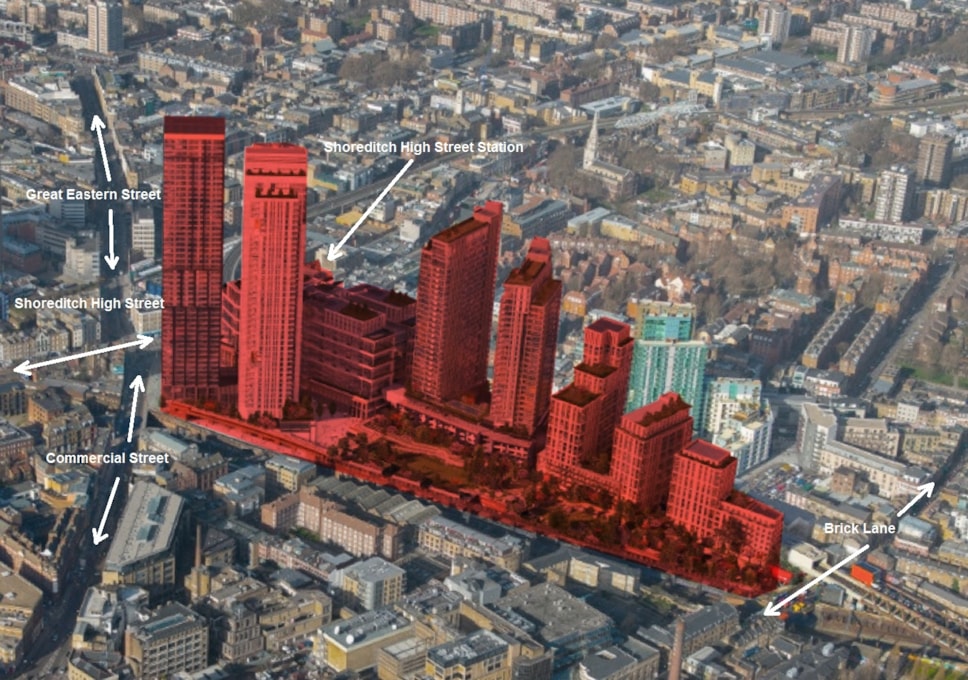
Mayor Pipe's response to the Bishopsgate Goods Yard consultation
Below is Mayor Jules Pipe's formal response to the current consultation on the proposals for the Bishopsgate Goods Yard. More information on the proposals, including maps and artist's impressions, and the current consultation, which closes on Monday 15 February, is available here.
Dear Boris
I am writing to respond to the consultation on the development proposals for the Bishopsgate Goods Yard site, being carried out under Regulation 22 of the Environment Impact Assessment Regulations 2011, GLA ref D&P/1200c&d.
Before I lay out the reasons why I believe the current proposals would be hugely detrimental to Shoreditch, its residents, businesses, character and heritage, I want to make clear that I support the principle of high density redevelopment of this key site, which for too long has sat largely derelict.
The Bishopsgate Goods Yard represents a fantastic opportunity for regeneration. With a bit more thought and imagination it’s entirely possible to design a scheme more appropriate in scale, which generates the right kind of business space for growth and job creation, and provides a good mix of housing, while still meeting reasonable expectations on the part of the developer. Done well, with effective collaboration between the developer, the councils, residents and businesses, we could create something which sets a bright and innovative future for Shoreditch and Tech City.
Unfortunately, in this instance, the developers showed very little interest in collaboration and what we have ended up with is something which serves primarily their financial interests.
Of the 12 buildings proposed across the site, the tallest is 177.6m (47 storeys) - that's more than five times the height of the TEA building opposite, equivalent to the Gherkin, BT Tower and Tower 42, and would make it the fourth tallest building in Canary Wharf, if placed there. Its next-door tower, 152m (39 storeys), also dwarves the neighbourhood, and even the lowest building, 24m (7 storeys), stands taller than the vast majority of nearby properties.
In no one’s eyes, provided they were not blinded by the potential profit they were making, could such an enormous height and volume of buildings be seen as appropriate to be landed in the heart of this vibrant neighbourhood, casting a shadow over hundreds of homes and businesses.
Most of the development would comprise of apartments, the cheapest of which would be studio flats. Price comparisons with similar nearby developments would suggest these could sell for about £700,000, and one bedroom flats for more than £1 million. These expensive flats are not the sort of homes we need. They will be far beyond the reach of most Londoners and do nothing to help address the capital’s housing crisis.
You have said yourself on more than one occasion that you do not believe the answer to London’s housing shortage is ‘high rise rabbit hutches’. I entirely agree.
Then there’s the shocking degree to which the developer’s viability assessment seeks to short-change the people of Hackney and Tower Hamlets regards the lack of ‘affordable’ homes and community contributions. This was laid bare by the independent viability assessment carried out by BNP Paribas. Although the developers claim to owe the community no affordable housing and offer a paltry 10% out of “goodwill”, BNP Paribas found more than 30% on site with a further £12 million towards off-site provision would be viable. It identifies ‘distortion’, ‘double-counting’ and a ‘lack of transparency’ throughout the developer’s assessment, argues they have ramped up their costs and downplayed profits, and predicts our communities would be short-changed by the current S106 money being offered.
The amount and type of proposed commercial space also brings no value to Tech City and could actually lead to the dissipation of this growing and increasingly renowned cluster of design and tech companies, as it changes the feel and direction of the area. The Goods Yard site is supposed to be earmarked for a commercially-driven development, something which the current application is certainly not.
The developer’s arguments requesting you call in this decision were misleading and extremely cynical, and it appears that this was their strategy all along. In no way had Hackney’s or Tower Hamlets' planning departments failed in their duties in the treatment of this application. Instead, they’ve tried very hard to work constructively with the developers to make them understand how they could make an appalling proposal more acceptable in terms of design, provision of employment space, more transparent consideration of viability, and impact on the two boroughs.
As it stands, this scheme will serve primarily to line the pockets of developers and property investors and is an example of everything that is wrong with the capital's property and development market.
It would simply be shameful if such a cynical, slapdash application for a major regeneration project in the heart of one of London’s best known and best loved neighbourhoods was waved through.
I sincerely hope that when you make your decision on this application that foremost in your mind are the residents, businesses, heritage and character of Shoreditch, both current and future.
It is a decision which for the people of Shoreditch, and the boroughs of Hackney and Tower Hamlets, will have ramifications for many decades to come.
Please find below the list of technical planning grounds on which I believe this application should be rejected.
Yours sincerely,
Jules Pipe
Mayor of Hackney
The technical planning grounds on which I believe the application in Hackney should be rejected are as follows:
- The proposals represent over-development as evidenced by the severity of the impacts that they would have upon townscape, local character and the amenity of nearby residents and businesses. Moreover, the proposals do not provide public benefits commensurate with a development of this scale to outweigh the adverse impacts. The proposals are considered to be contrary to London Plan Policy and more generally the development principles of the Bishopsgate Goods Yard.
- The proposals are not an employment-led development, which they should be. The application fails to demonstrate that the maximum economically feasible amount of employment floorspace has been provided. The residential-led mix of uses is considered likely to undermine existing business function and threaten the expansion of Tech City and continued business growth in the City Fringe.
- The proposed offer of 10% affordable housing is extremely disappointing given the scale of the proposed development. In light of the independent review of the scheme's viability carried out by BNP Paribas, it is considered that the proposed development could provide a substantially greater amount of affordable housing. Furthermore, the proposed affordable housing offer has not been adequately developed to ensure a fair and reasonable split between the administrative areas of the Hackney and Tower Hamlets.
- The detailed proposals for the listed Oriel Gate and associated structures result in direct and substantial harm to the designated heritage asset. It is considered that the development goals could be achieved without the harm caused.
- The development proposals as a whole are considered to be harmful to the setting of the listed Oriel Gate and Braithwaite Viaduct by virtue of the location, plot coverage, massing, height and design of the main buildings.
- The proposed development is not considered to be of excellent architectural design, and the qualitative assessment of the effects of the development is consequently flawed as it relies on the assumption that the views will be improved due to the quality of the proposed architecture. It is considered that the proposed development impacts negatively on a number views of, within and across numerous nearby heritage assets, where the development is obtrusively visible and is out of scale with local and historical norms characteristic of the heritage asset resulting in harm to the heritage asset.
- It is noted that proposed Building F would be visible between the corner turrets of the White Tower in submitted visualisations from the South Bastion of Tower Bridge. This effect on the view of the World Heritage Site is considered harmful to its setting and subject to conservation objection.
- The proposals for Plots F and G are not considered to represent exceptional, high quality tall buildings that respond to, and reflect the significance of the site or the context of the area. The two tower approach on these plots, primarily because of the monolithic coalescence in many important local views, is considered to be flawed and cannot be overcome with architectural devices and visual distinctions between the two buildings. The proposed buildings appear monolithic and lack slender profiles and proportions, which in combination with the narrow 10 metre separation distance lends to the buildings an inelegant proportionality. The large podium structure on these plots is out of keeping with the character and grain of the area, and detracts from the quality of the new public spaces. As a result these buildings have an adverse impact on a number of views and heritage assets within the site and the wider setting.
- The height combined with the footprint and massing of the proposed buildings on Plots A and B results in an overbearing scale that is alien with the local context. The buildings by virtue of their excessive scale and massing are considered harmful to the setting of the Grade II listed Oriel Gateway on site and heritage assets within the wider setting. The buildings also impact upon the quality of the new public realm within the site.
- Plots C, D, E are located fully within the Tower Hamlets part of the site. Nevertheless, the proposed procession of towers over these plots has a cumulative impact on townscape from Hackney.
- The proposals are considered to have severe adverse impact on daylight to a large number of properties within the surrounding area, and a number of locations have been identified where impacts and retained levels of light are not considered acceptable.
- The assessment against Air Quality Neutral requirements show that the development does not meet the required standard. On this basis, the development is not considered acceptable as currently proposed. Overall the Air Quality Assessment sections included in the Environmental Statement (ES) have not shown that the development is acceptable in Air Quality terms.
